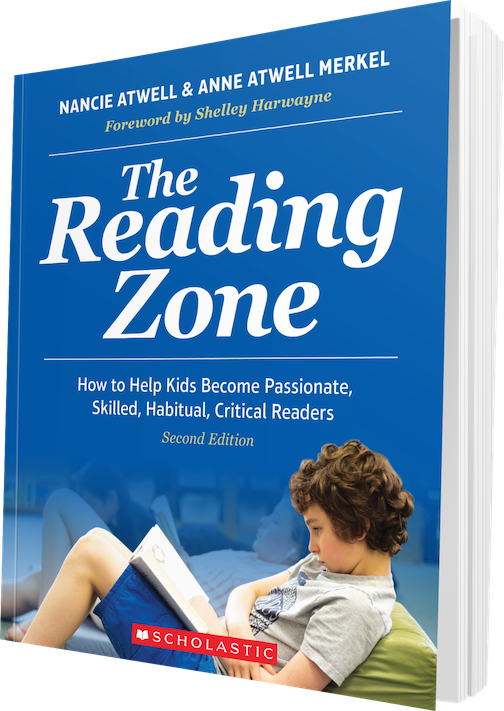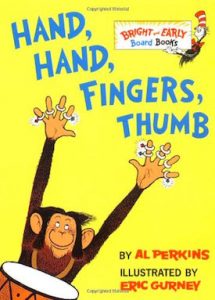 I remember back when I was in fifth grade…we were all reading and I was so immersed in a book that I literally forgot where I was. I remember hearing laughter, but the pull of the book kept my attention. Then there was more laughter. Finally I looked up and realized that the class was laughing at me!
I remember back when I was in fifth grade…we were all reading and I was so immersed in a book that I literally forgot where I was. I remember hearing laughter, but the pull of the book kept my attention. Then there was more laughter. Finally I looked up and realized that the class was laughing at me!
I’m sure that I was mortified at the time, but my memory lingers because that moment might have been the first time that reading a book took me into what Nancie Atwell calls the “Reading Zone.” While I don’t remember the book, what I do remember is being completely captivated by the story and not wanting to stop.
That’s one of the reasons I loved reading The Reading Zone: How to Help Kids Become Passionate, Habitual, Critical Readers by Nancie Atwell and Anne Atwell Merkel. This amazing mother-and-daughter team taught for years at the Center for Teaching and Learning (CTL), a K-8 school in New England. Nancie is now retired, but her passion for reading remains.
 The authors deeply believe that, beginning in kindergarten, all children should have access and time to read the books of their choice. While some of you may be shaking your head at that statement, let’s take a step back and understand Atwell and Merkel’s point of view.
The authors deeply believe that, beginning in kindergarten, all children should have access and time to read the books of their choice. While some of you may be shaking your head at that statement, let’s take a step back and understand Atwell and Merkel’s point of view.
- We become better readers when we read more often.
- We tend to stick with books that interest us.
- Children in a class have a wide variety of interests.
- Children in a class are at different reading and comprehension levels.
- Choice helps guarantee that children will read all the time, not just when they “have to.”
- This statement doesn’t preclude assigning books to read as long as students also have choice in reading materials.
Beginning Reading is the Foundation
The Alabama Reading Initiative helps equip teachers with the knowledge and skills to teach beginning reading. But it’s up to the classroom teacher to build student comprehension skills throughout the reading process and beyond. Atwell and Merkel believe that “when reading is meaningful, understanding can’t be separated from decoding” (p. 12).
 Think back to the first time you held a book. Chances are that you weren’t yet a proficient reader. Parents and children reading books like Go Dog Go, Runaway Bunny, and a favorite of one of my son’s, Hand, Hand, Fingers, Thumb, strengthen comprehension. Young children want to hear the same book over and over again. And, as they listen, they not only make meaning, but they begin to understand and decode the words.
Think back to the first time you held a book. Chances are that you weren’t yet a proficient reader. Parents and children reading books like Go Dog Go, Runaway Bunny, and a favorite of one of my son’s, Hand, Hand, Fingers, Thumb, strengthen comprehension. Young children want to hear the same book over and over again. And, as they listen, they not only make meaning, but they begin to understand and decode the words.
Sadly, not all young children have the chance to hold and learn from books. And, many who do, lose interest in reading for a variety of reasons.
Creating Life-Long Readers
Atwell and Merkel provide the antidote: Reading workshop, in which children are provided with significant blocks of time to read books of their choosing. And, where children are expected to read for 30 minutes EVERY night, even on the weekend, to develop a lasting reading habit.
To realize this goal, students need wide access to a variety of well-crafted books. And, teachers must help direct them to books that might interest them. One way to gauge student interest is to survey them at the beginning of the school year. The Reading Zone provides a survey created by Atwell and Merkel. A similar reading interest survey can be found here.
Booktalks and Recording Progress
Once the teacher knows a student’s interest, she can guide him/her to specific books using booktalks, which Atwell describes as a “combination of community service and sales pitch” (p. 41). Students listen as the teacher briefly describes the book, its major themes, and why they might find it of interest. Students keep track of the books they read and want to read using a simple coding:
JR: Just right—fits my reading comprehension level
H: Holiday—an easy read or the desire to reread a favorite book
C: Challenge—might need help with some of the words
The authors encourage teachers to point students mostly to the JR category, although an occasional challenge with support, particularly if it addresses one of the top interests of the student, should be pursued. And, of course, rereading and joyful reading is always important. In fact, just recently I picked up an old favorite to reread perhaps for the fourth time, A Boy’s Life, by brilliant, bestselling Alabama author Robert McCammon.
Conferring and Letter Essays
Rather than conduct whole book studies in the classroom, teachers confer and expect students to write about what they’ve read. The authors reference a meta-analysis of reading by Graham and Herbert that notes:
Having students write about a text should enhance reading comprehension because it affords greater opportunities to think about ideas in a text, requires them to organize and integrate those ideas into a coherent whole, fosters explicitness, facilitates reflection, encourages personal involvement with texts, and involves students in transforming their ideas into words (2010).
Students write letter essays to teachers every three weeks about a book they read. Teachers using this process provide students with explicit instructions and exemplars to help them prepare.
And, with practice, many of these letter essays are quite eloquent. For example, I’ve captured a short excerpt from a letter essay featured in the book, written by an eighth grader who read the Walls Around Us by Nova Ren Suma:
The plot of this book was so complex and beautifully intertwined, I felt the need to skim through it again after completing it, and I’m glad I did.
One Disclaimer
There is one point made by the authors of The Reading Zone with which I disagree. The authors are not fans of the Common Core State Standards, which Alabama used as the basis for its College and Career Ready Standards. The authors argue that the CCSS regard fiction as “nonessential, impractical, frivolous even” (p. 108) due to the increased emphasis on nonfiction.
This view seems to be a common misconception about the CCSS English Language Arts standards, which encourage students to read across all subjects, not just in English class. The CCSS are targeted for math and English classes, but they also encourage science and social studies teachers to incorporate reading into their lessons.
Some history: During the several years it took to develop the CCSS, there was discussion (and evidence) that in some ELA classrooms there was not much focus on nonfiction outside the core textbooks. It’s certainly true that since the implementation of CCSS and CCRS, many more teachers have brought quality nonfiction literature into their lessons and classroom libraries. That’s a good thing!
 There is abundant evidence that fiction is alive and well in English classes that use the CCSS.
There is abundant evidence that fiction is alive and well in English classes that use the CCSS.
On the website for the CCSS, there is a substantial list of exemplars and suggested stories, books, plays, and poems to teach. Here in Alabama, the organization Alabama GRIT—Graduate Ready. Impact Tomorrow.—held a campaign on Twitter a couple of years ago to combat the misconception that fiction was no longer being taught. Students from English classes all over the state sent in pictures of themselves holding up classics they were reading like Romeo and Juliet.
Getting Lost in the Zone
Taking into account my one disclaimer, The Reading Zone can be a valuable resource to teachers wanting to strengthen comprehension skills and love of learning. It joins The Book Whisperer by Donalyn Miller as one of my favorite go-to books for teaching reading. The goal I think we all share is this: we want every student to get “lost in the zone” reading something they love.

0 Comments on "We Want All Our Students to Get Lost in “The Reading Zone”"